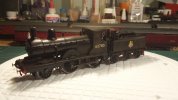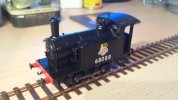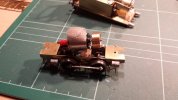In my 'Hello from Scotland' thread in the new members forum, I mentioned my three interests which are primarily BR (GER), then BR (Midland) and industrial. So, I thought I would post items of what I've done in the past, what I'm doing at the moment and what I hope to do in the future.
My first piece is about a BR(E) E4 2-4-0. This class of loco were quite prevalent over the East Anglian lines with the last one, 62785 (on which this model is based) mainly running on the Stour Valley lines until it was retired from service. It's now been cosmetically restored and is part of the national collection.
The basis of the loco is a Nu-cast (ex Stephen Poole) white metal kit. The chassis was built from Alan Gibson milled main frames with the motor being a Mashima can (can't remember the size) driving the rear driving axle of the locomotive through a High Level gearbox. There is compensation between the first and second axles, the beam being biased 2:3 to the driving axle.
Somewhere, I have video of the loco running on Blackwell Brewery Company, the EM gauge layout of Mid Essex MRC. I'll dig them out so you can see the loco in operation. Yes, I'm biased, but it does run well!
More to follow.

My first piece is about a BR(E) E4 2-4-0. This class of loco were quite prevalent over the East Anglian lines with the last one, 62785 (on which this model is based) mainly running on the Stour Valley lines until it was retired from service. It's now been cosmetically restored and is part of the national collection.
The basis of the loco is a Nu-cast (ex Stephen Poole) white metal kit. The chassis was built from Alan Gibson milled main frames with the motor being a Mashima can (can't remember the size) driving the rear driving axle of the locomotive through a High Level gearbox. There is compensation between the first and second axles, the beam being biased 2:3 to the driving axle.
Somewhere, I have video of the loco running on Blackwell Brewery Company, the EM gauge layout of Mid Essex MRC. I'll dig them out so you can see the loco in operation. Yes, I'm biased, but it does run well!
More to follow.



